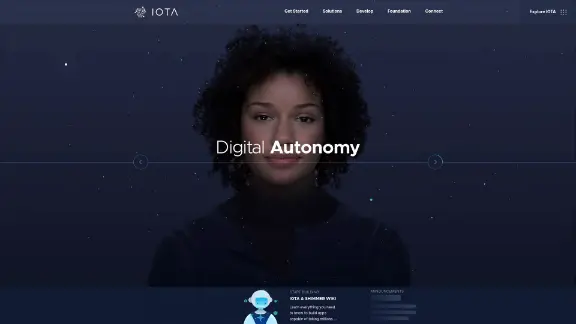IOTA (IOTA)
IOTA is a public distributed ledger that utilizes a directed acyclic graph (DAG) structure known as the Tangle to store transactions. It is designed specifically for the Internet of Things (IoT), enabling secure and feeless microtransactions between machines and devices.
Overview
IOTA was co-founded by David Sonstebo, Dominik Schiener, Sergey Ivancheglo, and Serguei Popov in 2015. Serguei Popov authored the IOTA white paper, which was published on December 28, 2017. The white paper emphasizes the importance of micropayments in the IoT industry, noting that paying fees larger than the transaction value is illogical. IOTA's Tangle technology allows for feeless transaction consensus.

| Ticker | IOTA |
| Category | Internet of Things (IOT) |
| Website | http://iota.org/ |
| @iota | |
| https://www.reddit.com/r/Iota |
Characteristics
Tangle
The Tangle, IOTA's core technology, features a Directed Acyclic Graph (DAG) structure. Unlike traditional blockchains with linear transaction sequencing, IOTA's transactions interlink in a web-like format. The network uses a Proof-of-Work (PoW) mechanism where each user verifies two previous transactions with minimal computational effort before sending their own. This approach eliminates transaction fees and allows for immediate transaction validation.
Feeless transactions
IOTA transactions are feeless, enabling users to send and receive tokens without costs. This is particularly advantageous for microtransactions in IoT applications.
IOTA’s network resilience
The Tangle technology is resilient to quantum computing threats and 51% attacks. IOTA's network topology requires significant control over the network hash rate, a complete view of the network, and collaboration with many nodes for a successful attack, making it highly secure.
IOTA token
The IOTA token is the native cryptocurrency of the IOTA network, used to transfer value and as a reward within the network's consensus mechanism.
MIOTA
MIOTA, or Mega IOTA, represents larger quantities of IOTA, with 1 MIOTA equating to 1,000,000 IOTA. This unit simplifies the representation of larger amounts.
Token distribution
- Initial supply: IOTA's total supply was created in a Genesis transaction, totaling 2.78 million MIOTA. This is the maximum supply, with no new tokens to be created.
- No miners: IOTA does not use miners, so there are no mining rewards. All tokens were created in the initial Genesis transaction.
- Founders and developers: The founders and developers did not reserve tokens for themselves but participated in the crowdsale to acquire them. The IOTA Foundation later received community donations for development and operations.
- Community donations: Post-crowdsale, the community donated a portion of their holdings to establish the IOTA Foundation, ensuring long-term project success.
- Distribution to users: After the crowdsale, IOTA tokens became available on cryptocurrency exchanges, facilitating wider distribution.
IOTA Foundation (IF)
Founded in 2017, early IOTA token investors donated 5% of the total supply to support the IOTA Foundation. Officially established in Berlin in 2018, the Foundation focuses on research, development, education, and standardization of IOTA technology. It is a member of the International Association for Trusted Blockchain Applications (INATBA) and a founding member of the Trusted IoT Alliance and the Mobility Open Blockchain Initiative (MOBI).
IOTA 1.5 (Chrysalis)
Chrysalis, also known as IOTA 1.5, is an upgrade for the IOTA network conducted in two phases.
Chrysalis Phase 1
Implemented in August 2020, this phase enhanced transaction throughput, reduced network congestion, improved security, introduced the UTXO model, and supported reusable addresses.
Chrysalis Phase 2
Launched on April 28, 2021, this phase introduced atomic transactions, a new signature scheme, improved hardware wallet support, and removed obsolete features. It set the stage for IOTA 2.0 (Coordicide), aiming for full decentralization by eliminating the Coordinator.
IOTA 2.0 (Coordicide)
Coordicide refers to the initiative to remove the Coordinator, a temporary centralized component, achieving full decentralization. Coordicide introduces a decentralized distributed ledger, a new consensus mechanism, and sharding to enhance scalability.
Shimmer network
Launched on September 28, 2022, the Shimmer network serves as a testing platform for IOTA protocol innovations. It uses the native token SMR and tests upgrades like the IOTA Stardust Tokenization Protocol before mainnet integration. Shimmer operates with feeless and scalable transactions using Tangle DLT.
IOTA SDK
On July 24, 2023, the IOTA Foundation released the 'iota-sdk 1.0', a Rust-based project. The SDK interfaces with nodes on the Shimmer and IOTA networks and includes client and wallet modules.
Features
Client module
The client module provides low-level functions for precise control over interactions with Shimmer nodes and allows advanced operations.
Wallet module
The wallet module manages accounts, generates addresses, and interacts with the Shimmer network, offering an easy-to-use interface for developers.
Bindings
The SDK includes Python, Node.js, and WASM bindings, ensuring compatibility across platforms and flexibility for developers.
E-Krona
In September 2017, Sweden's central bank, Riksbank, explored digital currencies through the E-krona project due to declining cash use. The IOTA Foundation was among 19 organizations selected for dialogue to assess the potential issuance of an electronic krona.
Investments
Bosch
In December 2017, Robert Bosch Venture Capital GmbH invested in IOTA by acquiring tokens, aiming to advance the technology's adoption and ecosystem development.
ITIC
In January 2018, IOTA partnered with the International Transportation Innovation Center (ITIC) to establish smart mobility testbeds for autonomous vehicles using IOTA's distributed ledger technology.
Tangle EE
The IOTA Foundation, in collaboration with the Eclipse Foundation, introduced IOTA's Distributed Ledger Technology to enterprises through the Tangle EE project. Launched on February 11, 2020, Tangle EE empowers enterprises to build applications on IOTA technologies, overseeing projects like Tangle Identity and Tangle Marketplaces.
